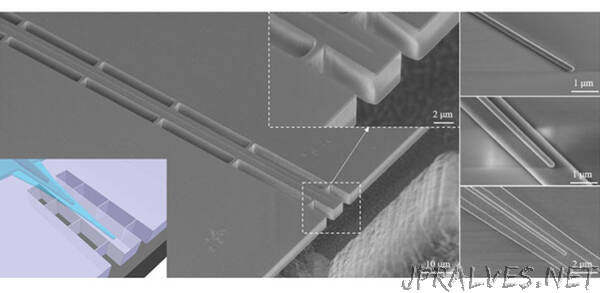
“Thin-film lithium niobate edge coupler enables on-chip second harmonic generation.
Thin-film lithium niobate (TFLN) has recently emerged as a versatile nanophotonic platform. With the advantages of high optical confinement, enhanced light–matter interaction, and flexible dispersion control, TFLN-based periodically poled lithium niobite (PPLN) devices outperform their legacy counterparts in both nonlinear optical efficiency and device footprint.
A major challenge of TFLN-based PPLN devices is how to achieve efficient and broadband off-chip coupling. Due to the lack of an efficient broadband coupling scheme, the overall and on-chip second-harmonic generation (SGH) normalized efficiencies (fiber-to-fiber) are too low for many practical applications of TFLN-based PPLN devices. To date, it is possible to achieve high coupling efficiency at the C-band, but an efficient edge coupler that can cover both near-infrared (~1550 nm) and near-visible (~775 nm) wavelengths has not been developed until now.
As reported in Advanced Photonics Nexus, researchers from Sun Yat-sen University and Nanjing University designed and fabricated an ultrabroadband and efficient TFLN edge coupler. They found that the conventional two-layer coupler does not work well in the 775-nm band, due to the refractive index mismatch between the cladding waveguide and the spot size converter (SSC) structure. To address this issue, they designed an efficient coupler working at both 1550 nm and 775 nm. It consists of a suspended SiO2 waveguide with supporting arms and a tri-layer SSC, including top-, middle- and bottom-layer tapers. The light from lensed fiber is coupled into the SiO2 waveguide, and then transferred to the TFLN-rib waveguides through the SSC. The tri-layer SSC solves the coupling issue of the conventional two-layer coupler structure at short wavelengths. The measured coupling loss is 1 dB/facet at 1550 nm and 3 dB/facet at 775 nm.
The work also demonstrates the advantages of the designed coupler in nonlinear applications. They achieve a record high overall SGH normalized efficiency with a fiber-to-chip coupling scheme, and a high corresponding on-chip second harmonic efficiency. Compared with the state-of-the-art devices, the overall normalized efficiency is reportedly greater by two to three orders of magnitude.
Senior author Xinlun Cai, professor at Sun Yat-sen University’s School of Electronics and Information Technology, remarks, “Increased fiber-to-fiber SHG efficiency is a critical aspect of almost all photonics demonstrations. It is of particular significance to nonlinear and quantum photonic chips, which are often touted as appropriate for use in next-generation photonic systems but suffer from very high coupling losses.” The team anticipates that their work will expand practical applications of TFLN-based PPLN devices.
Read the Gold Open Access article by Liu et al., “Ultra-broadband and low-loss edge coupler for highly efficient second harmonic generation in thin-film lithium niobate,” Adv. Photon. Nexus 1(1) 016001 (2022), doi 10.1117/1.APN.1.1.016001.”
